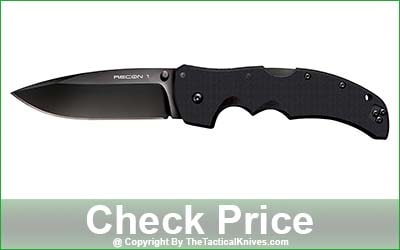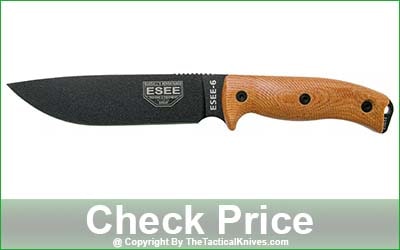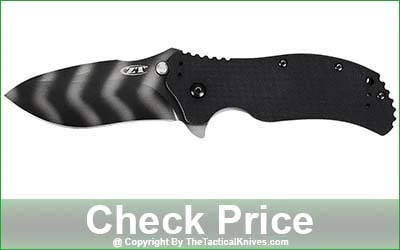Every hunter needs a durable knife that will last. Choosing a hunting knife can be intimidating with so many options, specifications, and price points. When buying any knife you need to choose if you want the best fixed blade knife or folding knife, how long you want the blade to be, what material you want the blade made out of, the shape of the blade, the grind of the blade, the knife tang if you choose a fixed blade knife and the material and shape of the knife handle.
Best Hunting Knife – Top List
- Buck Knives 119 Special Fixed Blade Hunting Knife
- KA-BAR Full Size US Marine Corps Hunting Fixed Blade Knife
- Cold Steel Recon 1 Series Hunting Pocket Knife
- ESEE 6 Fixed Blade Hunting Knife
- Kershaw Blur Black SpeedSafe Assisted Hunting Pocket Knife
- Gerber StrongArm Fine Edge Fixed Blade Hunting Knife
- Buck Famous 10 Folding Hunter Knife
- Buck 192 Vanguard Fixed Blade Hunting Knife
- Zero Tolerance 0350TS Tiger-Stripe Folding Hunting Knife
Best Hunting Knife
1. Buck Knives 119 Special Fixed Blade Hunting Knife
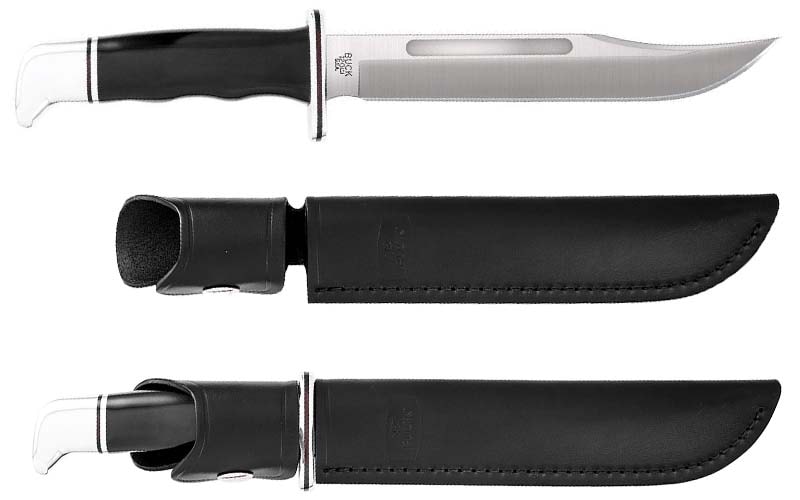
First of all, you should know that this “119 Special” is a robust and No-1 fixed blade knife Buck company has ever made.
If you are an outdoorsman or a hunter who wants something just a little extra that the strength and dependability of a fixed blade knife can offer, the Buck 119 Special Hunting Knife is probably just the thing for you.
The trust that knives like these earn comes from generations of users who have looked to them to save themselves in countless situations.
The Buck-119 comes with a 6″ clip point blade that is fixed into the handle to ensure long life. The knife has a total length of 10.5″, the weight is 7.5 oz and a full tang hunting knife that will provide you with excellent balance in different chores.
The blade core is made out of 420HC stainless steel (HRC 56-58). Because of the heating, freezing, and reheating of the steel core, the blade stays sharp longer after heavy use. The 420HC is a sturdy, workhorse steel that is known for higher edge retention, corrosion resistance, and ease of sharpening.
The handle of this top-rated Buck knife for deer hunting is made of traditional black phenolic with a polished aluminum pommel/guard. The size of the handle is good enough that it can be easily held in a large hand. I also got a good grip on wet, sweaty, or bloody hands during heavy work due to swells and guards.
Buck Knives 119 Special comes with a 100% originally fitted leather sheath. You can securely and safely carry it with your belt or into a bag.
The Buck 119 is proudly made in the USA. The knife also offers a lifetime warranty by Buck Brand.
Whether you use this one to hunt or survive with, or just use it as a general-purpose knife, you’ll be glad that you adopted this one like yours. This was the first model of knife that Buck Knives ever made back in 1902, and it remains the same quality tool today.
This top rated hunting knife is ideal for various works like survival, camping, and military use in any tight place. Also, the heavy-duty knife can be used for batoning, trimming, or cutting wood on outdoor trips.
Pros
- Best fixed blade Buck knife ever at a reasonable cost
- Heat treatment 420HC stainless steel blade
- The blade is very sharp out of the box
- Simple design knife for easy field-sharpening
- Perfect blade shape for killing and skinning the games
- The handle has palm swells for control and a solid grip
- A perfect-size guard ensures extra protection and balance
- Genuine leather sheath with snap fastener
- Life span warranty from Buck Company
- Extremely durable knife for various kinds of hard work
Cons
- This knife does not have any lanyard hole
2. KA-BAR Full Size US Marine Corps Fighting Hunting Knife
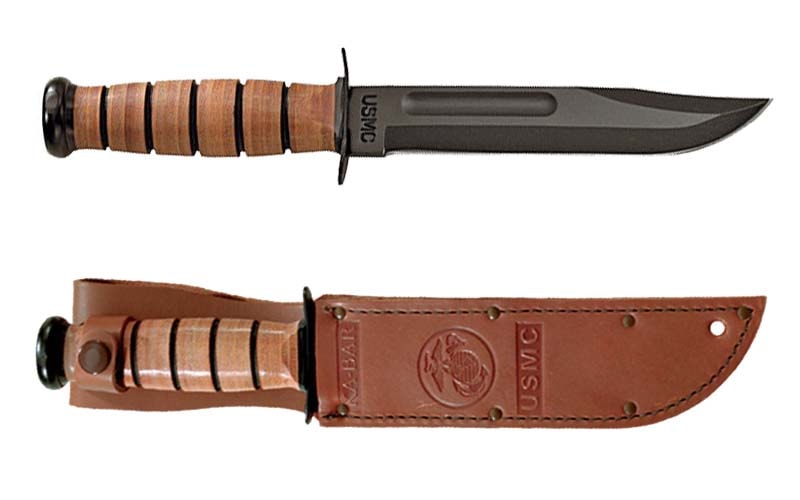
If you are looking for a good fixed blade knife under $100 that is featured with all-around functionality, you have just found it. During WWII, it was just a general combat knife. Today, KA-BAR Full Size USMC is one of the top fixed blade hunting knives in the world. KA-BAR has been manufacturing knives since 1898 and it is still the most famous fixed blade knife brand among the hunter, survivalists, military personnel, outdoor enthusiast, amateur collector, and traveler.
The Marine Corps has a 7″ clip point blade which is made of tough 1095 Cro-van Stainless Steel (56-58 HRC). An outstanding mixture of vanadium and chromium over the 1095 steel and black oxide finish – all has upgraded the blade’s sharpness, edge retention, and rust resistance. Because of its high carbon steel with a plain cutting edge, the 0.17″ thick blade is easy to re-sharpening if necessary, and higher edge retention helps to hold razor sharpness year after year. The full tang knife is designed with a slim-curved brass guard that is placed between the blade and handle to shield your fingers from the sharp edge.
This best rated hunting knife has an oval shape leather handle for a solid and comfortable grip. An easy-to-grip leather handle has a pommel on the base of it for emergency hammering. The sheath, made in Mexico, is 100% leather. The sheath is strong, durable, and rugged. It will not break and keep the blade sharp and protected. This 11.88″ KA-BAR knife is made in the USA and backed by a limited lifetime warranty.
3. Cold Steel Recon 1 Series Pocket Hunting Knife
If you are looking for a reliable folding hunting knife for use in extreme conditions, this latest model in the Cold Steel Recon 1 series is the best for you. From my research, the knife is very popular among tactical users such as fire and rescue crews, military and law enforcement personnel.
The hunting knife has a blade length of 4″, closed length of 5.38″, overall length of 9.38″ and weight of 5.2 oz. This best hunting EDC knife is reinvented to be 10% smaller and lighter than the original classic Recon 1.
Its 0.13″ thick blade is made of premium quality stainless steel CPM-S35VN (60-62). The blade has a black DLC (diamond-like carbon) coating that makes it stealthy, reduces friction drag, and makes it very hard to corrode.
The knife has a wide belly, spear point tip, and razor-sharp hollow grind plain edge making it an all-purpose blade. I have used the knife for almost all kinds of work like slicing, skinning, feathering sticks, chopping limbs or branches, push cutting of rope or seat belt or electric wires, etc and I have never been disappointed.
The handle fits like a glove and feels rock solid to me after holding it, but it’s also fairly light since it doesn’t have metal liners. The textured black G-10 handle scales and deep finger grooves gave me a non-slip grip and control, even with wet, sweaty, or oily hands.
Self-defense and quick action become easy since it comes with the Phosphor Teflon washers for the easy one-handed deployment of the blade. The knife can be opened easily with the ambidextrous thumb studs or with just a flick of the wrist.
The knife is equipped with a secure TriAd locking mechanism for nonstop use. The lock-up on mine is really solid with no wiggle side to side or up and down.
The knife also has a reversible pocket clip to mount tip-up carry on both right or left-handed sides.
Pros
- Ultra-premium CPM-S35VN stainless steel blade
- DLC coating does not wear off easily
- Blade came extremely-sharp from the box
- G-10 scales are light, strong & enough textured
- Handle sits well in my XL-sized hands
- Great ergonomics, allow different holding options
- The folder is big but not too heavy
- It comes with an extra pocket clip
- Knife features a limited lifetime warranty
- This model is made in Taiwan, not China
- Durable and reliable EDC, worth every penny
Cons
- No metal liners but the handle is enough strong
- The mechanism is a bit stiff at first
4. ESEE 6 Fixed Blade Hunting Knife
Important Features and Specifications: Blade Material: 1095 Steel; HRC: 55-57; Blade Length: 6.50″; Overall Length: 11.75″; Blade Thickness: 0.188″; Tang: Full Tang; Blade Point: Drop Point; Blade Finish: Powder Coat; Handle Material: Micarta; Handle Length: 5.25″; Knife Weight: 13 oz; Made In: USA; Warranty: No questions asked lifetime guarantee;
1095 HC Steel Blade: It came out of the box sharp enough to shave with. The perfectly sized (6.50″, Cutting Edge: 5.75″) and strong (0.188″ thick) drop point blade can handle almost any heavy-duty job.
I’ve baton 3-inch logs and wood for kindling; chopped down large saplings, swings, 4-inch logs, and branches in a few swings; made spares by feathering sticks; and slashed various things like cordage, rope, vines, and electric wire.
Despite all these heavy-duty, the heat-treated American steel blade was able to hold its edge very well. Being made of carbon steel and flat grind, easily can be field-sharpened with river stones. However, regular cleaning and oil coating are very important to prevent rust.
Natural Canvas Micarta 3D Handle: The 5.2″ long handle has contoured micarta scales, smooth finger choil, and jimping on the spine – overall the handle fits my large hand like a glove. The handle is easy to grip and control, even with wet or sweaty hands. Full tang construction and excellent weight distribution provide additional leverage in chopping.
Compared to the traditional handle, it is slightly rounded. It didn’t create any blister on my palm even after heavy chopping for long periods of time. The pommel with lanyard hole is flat/rounded which can be used for light hammering.
Polymer Sheath: The ambidextrous sheath is perfect for the outdoors as it holds such a large knife securely and the belt clip is sturdy enough and every button is steel, not plastic. Also got a chunk of paracord and a stopper thing with the sheath.
5. Kershaw Blur Black SpeedSafe Assisted Hunting Pocket Knife
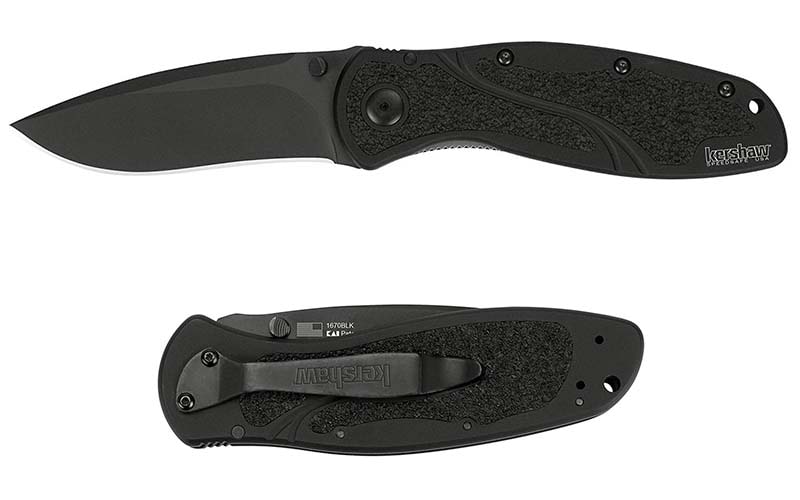
Kershaw is the leader when it comes to the production of best-assisted opening tactical knives under $100. I am loving my Kershaw Blur black! I used my previous blur so much but then I lent it to on of my cousins and never got it back. This is my everyday carry and I seem to find uses for it everyday.
For me, the Sandvik 14C 28N stainless steel 3.5-inch-long blade is perfect. I like the cerakote coating which provides a great corrosive resistance and is easy to clean. The gentle recurve on this slim blade makes it easy to use for all my multitude of tools. The drop point of this blade is secure and excellent for more precision uses.
I do not have to worry about the end chipping off. I use the hollow belly for cutting rope and strings but have been also using it to shave off the bark from branches when making skewers. It has a dependable sharpness. It has been easy to sharpen, and I like that it has a sleek beveled edge on top.
I found it easy to use for rope and for packaging. When I tried it out on my meats (steak, ribs, and more) it worked better than knives bought for the meat itself because of its light frame.
At fist glance at the handle of this knife it will provide a great grip with the perfectly placed “track-tec” inserts. It has an open construction with aluminum backspacers and an inset secure liner lock. The 6061-T6 anodized aluminum (with black anodized finish) is attractive, light, and sleek.
As always, the curvy Ken Onion design fits well in my hand. They also provide an added safety when in use. The rubber traction is nice without being like sandpaper. I would not want to leave it out in the sun.
The ergonomics of the thumb studs assists with one-handed easy opening. I like how there are grips on the thumb making it easier for my thumb to flip it open, even with gloves it worked well. When opening it the spring is super useful and you do not have to go through a full motion to open the knife. It easily flicks open with pressure from your thumb.
When it is open it has no wiggle room at all and is instead very sturdy when out. When doing the spine test, I found it very stable and did not move an inch.
I like the clip, when I put it in my pocket it is extremely comfortable and easy to clip. The pocket clip has never failed me and stayed in place. It does not dig into your pockets and slides gently into your pocket. Once in your pocket, it will stay in the same place unless you bump into something causing it to move.
It has a lanyard hole but honestly, I have never used it. The total open length of 7.9 inches (folded 4.5 inches) is easy to manage and use.
Pros
- Extremely Sturdy Knife, well crafted, great as an EDC
- Covered by Kershaw’s Limited Warranty
- Easy to sharpen blade, exceptional sharpness out of the box
- Handles have great grips, perfect for wet environments
- Lightning-fast, one-handed assisted opening system
- The spring is working consistently
- Awesome value for money in an American-made knife
- Sturdy and reversible pocket clip
Cons
- Trac-Tec grip occasionally gets stuck in pockets
6. Gerber StrongArm Fine Edge Fixed Blade Hunting Knife
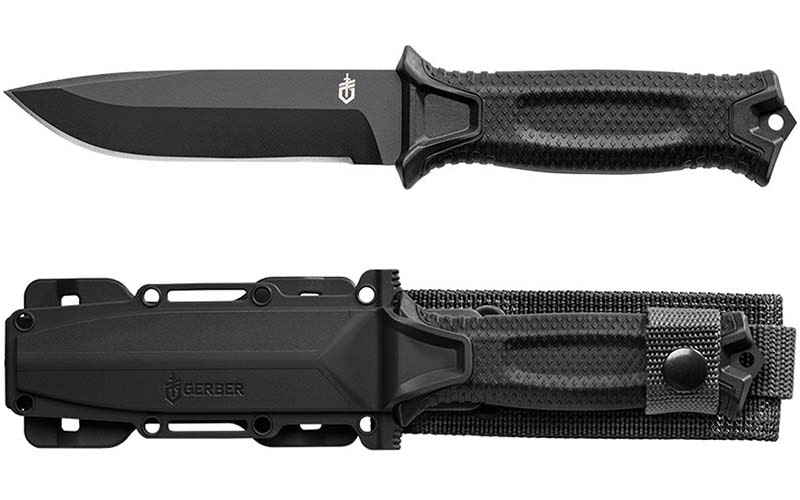
Gerber StrongArm is a full-tang hunting knife that stays true to the roots of traditional military-style survival knives. With a lifetime warranty, the 9.8″ long StrongArm is proudly manufactured in the USA at Gerber’s Portland, Oregon factory.
The hunting knife has a 0.19″ thick drop point blade made of 420 high carbon stainless steel (58-60 HRC) and protected with a black ceramic coating. The steel core contains additional amounts of chromium which enhances the toughness, corrosion resistance, and long-lasting sharpness of the blade.
Its 4.8″ long fine edge blade is capable of cutting hard to flexible materials such as ropes, set belts, branches, electrical wires, as well as batoning or chopping the firewood. Due to the high carbon steel, the blade quickly and easily takes a razor-sharp edge.
Its 5″ long ergonomic handle is crafted from Glass-Filled Nylon. The diamond-texture rubberized handle gives a comfortable and anti-slip grip that fits snugly in the user’s hand.
Also, the handle base has a small striking pommel that can be used to break through hard surfaces in emergencies or during rescue operations. There is also a lanyard hole in the pommel.
With the Gerber StrongArm, you can choose to carry your knife in many ways. From drop-leg system to MOLLE mount to horizontal belt mount – this 7.9oz weighing knife comes with a multi-mount sheath. The sheath allows both active and passive retention – relying upon the mount you use.
Check out its partially serrated version: Gerber StrongArm Serrated Edge Fixed Blade Knife
Pros
- Full tang design for good balance and solid construction
- Rust-free 420HC steel blade which can be sharpened easily
- The blade is strong enough and suitable for all kinds of hard work
- Remarkable edge holding capacity, no hassle for sharpening again and again
- Ergonomic handle for a comfortable grip and easy handling
- The handle is strong, stable, well-sized, waterproof, and unaffected by chemicals or weather
- The multifunctional sheath allows versatile and secure carrying options
- An American-made knife is absolutely worth every penny
Cons
- Some users are not happy with the pointed pommel
- Really nice knife, I couldn’t find any more cons
7. Buck Famous 110 Folding Hunter Knife
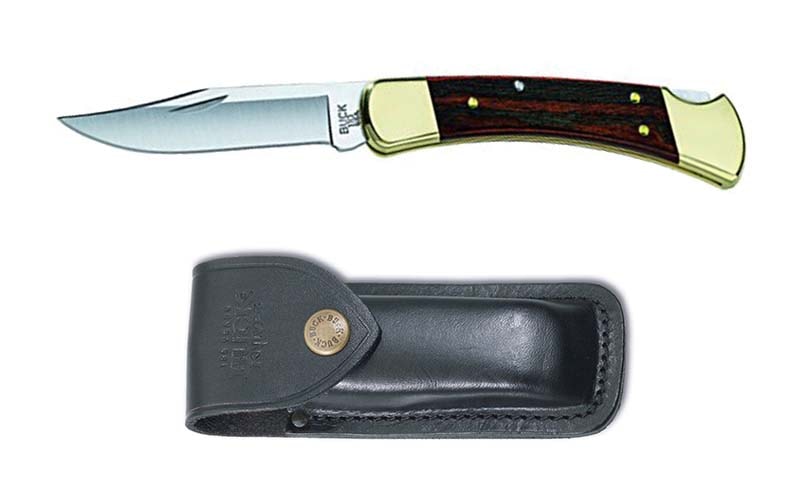
First, I would like to confirm that this Buck 110 is one of the best EDC knives under $50 and the No-1 Buck Folding Hunting Knife they have ever made. It’s hard to imagine any hunter or fisherman who doesn’t have fond memories of this knife.
You can find plenty of other classic knives everywhere, but when it comes to customizing everything you want in a hunting knife, only Buck can be depended on to deliver top-quality results to meet every requirement you have for the tools you use.
The blade core of this knife is made of 420HC stainless steel. Because of the steel’s Paul Bos Heat Treatment process (First heating the steel, then freezing and again reheating is called Paul Bos Heat Treatment System) the blade stays sharper for a long time under heavy use and also for edge retention, increases strength and corrosion resistance.
The crescent tip design razor-sharp blade is particularly useful for animal hunting and skinning. The 3.75″ clip blade is coming to the rescue when there was a use for a top-quality knife.
Even the Dymond Wood handle and brightly polished bolsters exude quality, from the tip of the blade to the finely crafted lock back. You will feel a comfortable feeling and grip while you will use it for any tactical or usual task.
There’s nothing like a Buck Knife, especially when you are depending on it for safety and trustworthiness. Interestingly, for everything that made it an iconic knife, the 110 Famous Hunter is the product that Buck Knives is most famous for.
Everything else fades in comparison with not only the quality of this special knife, but also the reputation that it has earned in the hunting spots, duck blinds, and fishing holes around the world.
This best Buck pocket knife comes with an equally high-quality and 100% original leather sheath. Due to its leather sheath, you can safely carry it in your pocket, bag, or with your belt.
It’s hard to mention the word Buck and not bring to mind the product that probably made them most famous, the 110 Famous Folding Hunter Knife. This knife is loftily made in the USA and provides a lifetime warranty.
This Buck pocket knife is highly recommended for cutting or trimming small wood, hunting, outdoors, tactical, or survival use in any tight places.
Pros
- In the Buck industry, it is the best Buck folding knife for EDC
- 100% secure lock-back locking mechanism
- Super quality Buck knife at a cheap price
- Suitable for all kinds of environment
- Original black leather sheath with snap closure
- Dymond wood handle with stunning brass bolsters
- Buck lifetime warranty
Cons
- Classic model knife with no SpeedSafe
- This folding knife does not have a lanyard hole
8. Buck 192 Vanguard Fixed Blade Hunting Knife
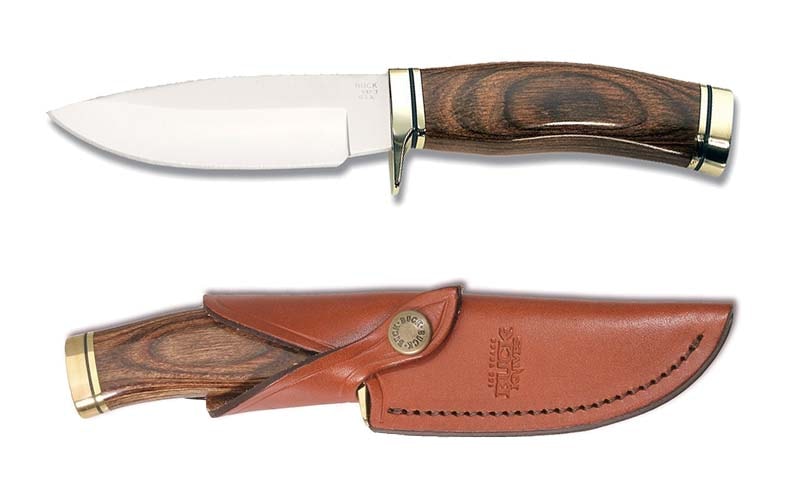
The first time you put this little powerhouse in your hand, the first thing that will come from your mouth is “Wow!” After all, that’s what most people say the first time they check out this little Buck 192 Vanguard. This Buck hunting knife has a fixed length of 8.125″ with a 4.125″ drop point of 420HC durable stainless steel made blade for excellent strength that will keep an edge under even the hardest use. The razor-sharp edge with the spacious hollow ground makes your hunting and skinning quite easy.
But the thing that really makes this one a winner is the feel of it. It feels every bit like the dynamo that it is. It’s a pleasure to use whatever you might happen to be doing, from field dressing to skinning to general cutting. It comes featuring a stunning heritage walnut contoured handle, finished by polished brass butt and pommel, which makes navigating through whatever you are cutting easy and quick. And when you’re done with this one just put it back into the sheath that you will be happy to hang on your belt.
Yes, it comes with an original full leather sheath. The leather sheath protects the knife from outside scratches and unusual circumstances. Additionally, this Buck knife has been produced in the USA. This Buck fixed blade hunting knife has a bigger hilt down the site of the knife, so there is no possibility of slipping or touching your finger with the sharp blade even if your hand waits with the animal’s blade. Everyone is sure to ask you about this one. This knife is sure to be an heirloom. You’ll be anxious to use this one every chance you get. This Buck skinning knife also comes with Buck’s lifetime warranty.
Pros
- Safe and useful hunting knife for difficult circumstances
- The razor-sharp blade has easy & fast shaping capability
- Heritage Walnut contoured handle
- Suitable for hunting, skinning, survival work
- High-quality leather sheath
- Bigger hilt for extra protecting
- Lifetime warranty from Buck Knife
Cons
- The blade does not have any lanyard hole
- Do not use it for any hard work
9. Zero Tolerance 0350TS Tiger-Stripe Folding Hunting Knife
This ZT Tiger Striped is one of the best folding knives under $200 available in the US market. It is ten percent lighter and smaller than its classic 3000 model. The weight is 6.2 oz, overall length 7.75″ and closed length 4.625″ which makes it easy to carry and use.
They are manufactured for heavy-duty use. It has a non-serrated blade for versatility in cutting. The knife can handle all the requirements of law enforcement officers, armed forces personnel, and first responders who have to be ready for anything requiring a knife.
The 3.25″ hollow grind blade is made of premium quality S30V stainless steel (57-59 HRC). This type of steel gives the blade excellent toughness and longtime edge-holding ability. The coating is Tungsten Diamond-Like Carbon (DLC). The coating is non-reflective; friction drag is reduced and helps to enhance corrosion resistance.
The textured G-10 scales in matte black give you a safe tight grip on the synthetic handle. Using a carry clip for either the right or left-hand knife includes a quad mounting system. You can carry the knife tip-up or tip-down.
This tactical folding knife has assisted one-handed opening using the technology of SpeedSafe. It is even easy to open wearing combat gloves because of the big ambidextrous blade protrusion.
Buy with confidence because this hunting pocket knife has a limited lifetime warranty against defects in material and workmanship.
Check out its combo edge EDC knife version: Zero Tolerance Tiger Stripe 0350TSST
Pros
- One of the affordable S30V EDC knives for hard use
- Additional carbon and vanadium in the steel
- This blade will stay sharp over the long haul
- SpeedSafe assisted mechanism for fast deployment
- Single-handed opening knife
- A reliable liner lock keeps the blade firmly in place
- A four-position convenient pocket clip
- Forever warranty from Zero Tolerance
- Tiger Stripe is manufactured in the USA
Cons
- 6.2 oz, slightly bulky to me
What Is the Hunting Knife?
The hunting knife I use is an Old Timer Schrade 1430t I got it from my grandfather. It is a fixed bladed knife with a gut hook. The blade length is 4.1 inches and it has a rubber handle that has a hole in it for a lanyard. It comes with a nylon sheath that has a belt loop. The blade material is high-carbon steel and has a plain edge. The knife keeps its edge good and is durable.
What Type of Game are You Going to Hunt?
I enjoy hunting and hunt several different types of game rabbit, squirrel, turkey, deer, crow, dove, and raccoon. Having a hunting knife comes in handy every time. Whether needing to cut open a bag of corn for baiting deer, scraping hides, field dressing, and even butchering your kill. Your knife is just as important as bringing a gun or bow to hunt with. Thats why ill never go hunting without carrying a knife.
Which Is the Best for Hunting – Fixed Blade or Folding Blade Knife?
A fixed blade knife is more durable than a folding blade but sometimes they are large, bulky and have to be attached to your belt or in your boot. But if you don’t mind having your knife attached to your belt then fixed blade has an advantage to folding blades because you are able to carry a longer bladed knife. A folding blade, on the other hand, is much smaller so they can easily fit in your pocket and not hang off of your body, but they are prone to folding up while in use. The durability factor of fixed blades is why I think they are better for hunting. It’s hard to chop with folding knives because they are too light and aren’t as sturdy. If you use your hunting knife for field dressing then a fixed blade knife also has an advantage because it does not have all the grooves in it like a folding knife you won’t get blood and dirt inside of it and it makes it a lot easier to clean.
Considering the Overall Length of the Hunting Knife
• Fixed: The overall length of a fixed bladed knife is almost always going to be longer than a folding knife because the handle and the blade are one solid piece. But the blade length can come in any length it is not confined to the length of the knife handle so you have more options depending on your preference of blade size.
• Folding: The overall length of a folding blade knife is shorter than fixed blades. When folded the knife is half its size and the blade cannot be longer than the handle of the knife because it is contained in the handle so this makes having long-bladed folding knives hard if not impossible. Read More: Best Folding Knife Under $200
How to Measure the Blade Length?
On a fixed bladed knife I start at the end of the handle right where the blade comes out and measure to the tip of the blade. On a folding knife, I measure from where the knife folds and measure to the tip of the blade.
• Small Blades: Small length fixed bladed knives are good because they do not take up as much room as larger ones they won’t be in the way as much as a medium or large sized fixed bladed knife. They are ideal for small cuts since they don’t have a large cutting area. You are able to use it for larger cuts but it will take more work than a bigger knife. If you use a small fixed bladed knife for skinning it would be best to use it on small game.
Small length folding knives are even smaller than small fixed bladed knives and they take up less space. Like small fixed bladed knives they have a small cutting area and are lightweight so they aren’t good for big jobs or chopping.
• Medium Blades: Medium sized fixed bladed knives take up more space and can be clunky on your side but these are more of a general purpose knife. These knives are good at cutting and chopping and will be good for skinning any size game.
Medium sized folding blade knives are good for people who do not want something large and in the way attached to their belt. They are good for slicing and skinning like a medium size fixed bladed knife. But folding blades aren’t as ideal for chopping.
• Large Blades: Large size fixed blades are quite big and can really get in the way. They do have a very large cutting area but can be too large and unwieldy. You can also have trouble using a large blade for skinning. Large blades are very good for chopping because of their weight and length.
Large folding blades can be in the way in your pocket but they are much smaller than large fixed blades. Like the fixed blades they will be good when used for slicing like if you are preparing meat or if you need to chop things. But they can be harder to control because of their size.
Choosing the Blade Material
Choosing the best blade material can be hard because there are so many options and the names are just a bunch of letters and numbers. The steel your knife is made out of can affect a lot it affects how easy or hard it is to get your knife sharp, how long the knife keeps its edge, it affects whether the blade will rust, how tough your knife will be, and how flexible you knife will be. When choosing your blade material you need to keep this in mind. There are plenty of different steel compositions and each one is unique and has its own abilities. Such as if the knife steel has a lot of carbon in it, it makes it tougher and holds its edge better. There are a lot of different elements that they mix with the steel though. They use carbon, chromium, cobalt, copper, manganese, molybdenum, nickel, phosphorus, silicon, sulphur, tungsten, and vanadium. Each of these elements do different things and will affect the overall quality of the blade. My choice for blade material is carbon steel because it is tough and keeps its edge. There is also the option of getting a decorative metal like damascus steel it has hundreds of layers and makes it have a decorative pattern throughout the metal, but this decorative material does not have any benefits compared to regular steel.
Selecting the Blade Shape or Tip
The shape of your blade is important because it affects how the blade will cut and chop. There are several different styles of blades like drop point, trailing point, clip point, straight point, and tanto point.
• Drop Point: On a drop point knife the spine of the knife slopes from the handle to the point of the knife blade. This style of tip provides the knife with a stronger tip and adds more control. The drop point does not have as strong of a point of a clip point but it is much stronger.
• Trailing Point: On a trailing point knife the point of the knife curves up at the tip of the knife. Trailing point knives are good for slicing and skinning because they have such a large cutting area. Trailing points have a weak point and can also be hard to put into a sheath.
• Clip Point: On a clip point knife the spine is straight for most of the knife then getting closer to the end it curves downward and comes back up making a half circle shape. The back edge of a clip point is also sharpened. The clip point is good for stabbing and slicing because it has a large cutting area. The disadvantage of the clip point is that the point is weak.
• Straight Point: On a straight point knife the spine of the blade is completely straight but the blade of the knife curves upward to the spine. This knife is good for general purpose and has a strong point. It has a large cutting area and is good for both slicing and stabbing.
• Tanto Point: On a tanto point knife the blade and spine are straight and at the end the blade meets the spine at a sharp diagonal angle. These blades are not very good for slicing and the point is hard to control. The pros of this type of blade is that is has an extremely tough point and it’s good for stabbing.
Grinds on Hunting Knives
Grinds on hunting knives. There are plenty of different kinds of grinds you can get on your knife hollow grind, chisel grind, flat grind, convex grind, high flat grind, compound grind, v grind, and asymmetrical grind. Each of these grinds will determine how easy or hard it is to sharpen your blade and how well your knife will cut. A common grind used for hunting is the hollow grind it has a razor sharp edge but is susceptible to bending and chipping and can dull quickly. The reason this grind is used for hunting is because it is useful for skinning animals.
Selecting the Blade Edge
When selecting a blade edge you have three options plain or flat edge, serrated edge or saw toothed edge, or a combination of both half serrated half flat edge. Each edge has its own pros and cons and each edge is better at doing different tasks. Each edge also keeps its edge or sharpness differently.
• Plain Edge: A plain edge knife is completely uniform throughout the blade of the knife there aren’t any serrations on it. Plain edge knives are a lot better for clean cuts they also give you a lot better control of the knife. Plain edge knives will give you clean cuts with a lot more accuracy than a serrated blade and are best for push cuts and slicing. Plain edge knives work better for skinning animals shaving and peeling than serrated blades. Plain edge knives have to be sharpened more often than serrated edges. The cons of using a plain edge knife is that they aren’t good using in a sawing motion.
• Serrated or Saw-toothed Edge: A serrated or saw toothed edge has serrations going down the edge of the blade similar to a saw. These edges are good for almost everything but they won’t give you a clean cut if you are using it on meat or skinning an animal or fleshing a hide. The serrations will give the knife good grip when cutting through hard surfaces. Even when the edge is dull serrated edge knives can still cut but it is a lot harder to sharpen a serrated edge knife and is more time consuming.
• Combination or Partially Serrated Edge: Combination blades half serrated half plain edge gives you the benefits of both edge types. You can use the plain edge for skinning an animal, fleshing a hide, shaving, and peeling. While you still have a serrated edge for tough cuts. The downside to these types of blades is that you only have half the blade to make slices with and do not have a large cutting area, and when you sharpen the blade you have to sharpen the two different parts two different ways by a knife sharpening system and it can be time consuming. But as long as you aren’t using this kind of blade for a lot of slicing it should be a good blade for most people.
Knife Tang For Fixed Blade
All fixed blade knives have a tang. What a tang is the metal from the blade that goes into the knife handle. The tang will ultimately determine how tough your knife will be and how easy it is to break.
There are several different styles of tangs like full tang, partial tang, push tang, encapsulated tang, hidden tang, rat tail tang, tapered tang, skeletonized tang, and extended tang.
A full tang, encapsulated tang, skeletonized tang, and extended tang are going to be the strongest because they take up all the space inside the handle. For professional hunters, I always suggest a full-tang tactical knife.
On the other hand, a rat tail tang is very thin and could snap with force, or a push tang could fall out of the handle if too much force is applied.
Considering the Knife Handle
The knife handle can be made out of a variety of different materials and each one has its own advantages, Whether you want a decorative handle, a rugged handle, a non slip, handle or more there are all kinds of options. The handle of a knife can be made out of metal, wood, bone, pearl, leather, plastic,rubber, or even rope. Metal handles are strong and can be made out of many different kinds of metals. Metal handles are tough but can be slippery they can corrode be brittle scratch easily and not be very good looking. Wood handles aren’t as tough but can be more decorative they can cost more for rarer types of woods. Woods are pious though and if used in wet conditions it can ruin your handle. There is also wood handles with resin in them and they are very tough and not as susceptible to water and wear as regular wood. Bone handles can be expensive crack easy and be slippery but they are good looking. Pearl handles are mostly for decoration and are expensive. Leather plastic rubber and rope handles are cheaper but aren’t as durable as metal or wood.
All about the Knife Sheath
Knife sheaths are used generally for fixed bladed knives to protect the blade and the user. They come in different shapes and materials. Most sheaths are made out of leather nylon, or plastic and are attached to your belt. Leather is the most durable but is pious and can be hard to clean and dry rot. Nylon sheaths can also get dirty and be hard to clean because of all the separate threads. Plastic sheaths are the easiest to clean and do not wear as much as nylon and leather.
Care and Feeding of Hunting Knives
Care for your hunting knife. After finding your perfect knife you will want to make sure it lasts for years if not a lifetime. You will need to know how to clean, sharpen, store, and keep your knife from rusting or the handle from rotting. To clean your knife you need to use soap and water. You should avoid using harsh cleaners. If you have stains that won’t come off you should use vinegar salt and a cork. To sharpen you knife you have a lot of different options. You can use a traditional water or oil stone, a knife sharpener that your run the blade through. or a knife sharpening system they usually cost a lot more. You will want to carefully run the edge of the blade over the sharpening stone at the right angle it will take some practice to get right. When you aren’t using your knife your need to properly store. You should put oil on it and store it in a dry area if you have a leather sheath then you should remove it because it can cause your blade to rust. Lastly you will need to prevent you knife from rusting you can easily do this by oiling your blade and if you have a wood or leather handle you should oil it too.
Final Verdict
If you are looking for the perfect hunting knife you should ultimately find something that will be comfortable in your hand, be able to perform the tasks you need it to do, and be strong enough to last you for years. My pick for a good hunting knife is a fixed bladed knife with a 6 inch drop point blade that has a full tang a wooden handle and a full flat grind with a plain edge. A knife with these specs will be durable and easy to sharpen and skin and flesh hides easily.
Read More Reviews Of:
- Best SOG Knife for Hunting
- Top 10 Zero Tolerance Knives
- Best Buck Knife for Hunting
- Best EDC Knives for $50
- Best Handmade Cowboy Knives
